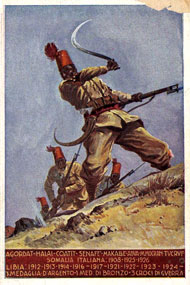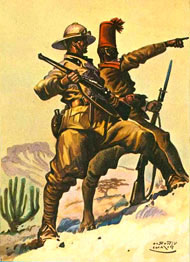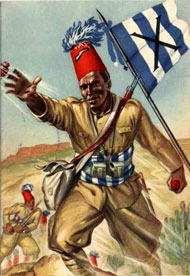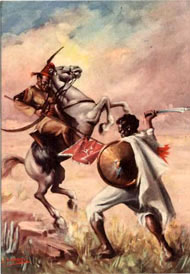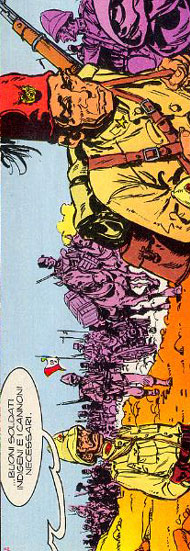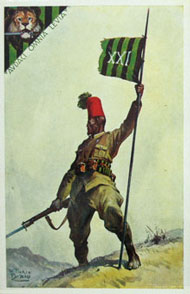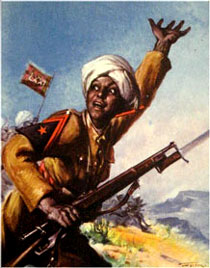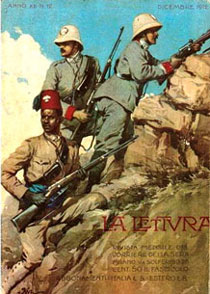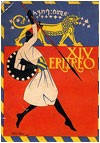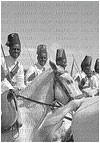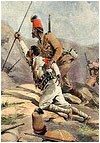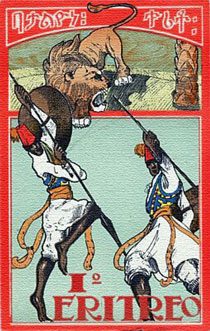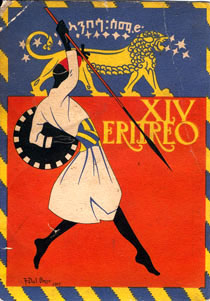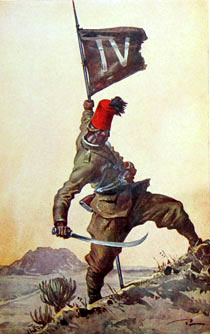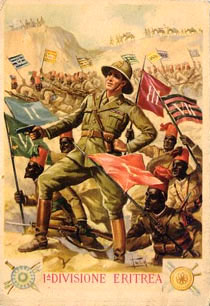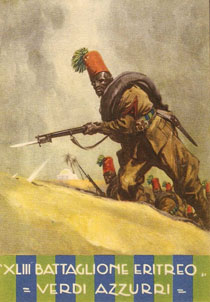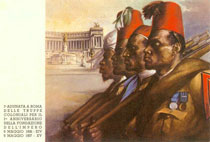Controstoria. ETIOPIA TRA MITI LEGGENDE E.....FINZIONE.
Traduci in italiano >>>
During the second half of the 19th century, the Horn of Africa was divided
among the imperial powers of France, Britain, and Italy. Ethiopia forged
alliances with European imperialists. These alliances made possible the
expansion of the Ethiopian empire and the subjugation of the peoples of
Oromia. The Oromo were the chief enemy of the Ethiopians. There are five
interrelated issues to be attended to if one is to understand these
relations and events: (1) the nature of European imperialism in the
region; (2) the development of the Ethiopian state and its linkages to the
capitalist world-economy; (3) the nature of the dependent relation between
Ethiopia and imperialism; (4) domination of the Oromo and the
transformation of the productive system into one predicated on export; (5)
the development of Ethiopian colonialism.
In 1840, the French and the British began supplying Ethiopian warlords
with weaponry. Christianity built a bridge between Europeans and
Ethiopians. The Oromo were characterized as pagans and savages. At first,
the Oromo prevented the Ethiopians from settling on their lands. Between
1855 and 1868, the Ethiopians began de-Oromoizating areas within their
control.
During the last couple of decades of the 19th century, two key figures
emerged: Yohannes IV and Menelik II. These two individuals and their
followers allied with the European imperial powers to expand their
territories and centralize their political rule. These activities laid the
foundation for the development of the Ethiopian state. Yohannes became
emperor of Ethiopia in 1872. Menelik allied with European forces and began
occupying Oromia. The Ethiopians defeated the Oromo between 1868 and
1900. Menelik forged deep linkages with the Europeans and worked to set up
a collaborative class in Oromia.
The European-Ethiopian alliance, the emergence of the Ethiopian Empire,
and the domination of the Oromo were deeply interrelated processes.
Obtaining European assistance and the expansion of territory through
colonization were integral processes of the incorporation of Ethiopia into
the capitalist world economy. These relations were commercial relations.
The Ethiopians were buying guns and other commodities and services, and
the thrust into Oromia was driven by a need to accumulate more wealth for
trade with Europeans. These activities demanded centralized state power.
There were two patterns of colonization in Oromia: conquest and
settlement. The Ethiopian colonial expansion resulted in mass killings,
destruction and expropriation of property, plundering, enslavement, and
cultural genocide. The Oromo became manual laborers, slaves, and servants.
The Oromo were exploited by multiple levels of ruling groups: (1) European
imperialists; (2) Yohannes (until 1889); (3) Menelik; and (4) Oromo
collaborators. The expansion and centralization of the Ethiopian state
was financed by expansion into the south. The system of wealth
accumulation was tributary and control of the slave trade. Between 1896
and 1910, a system of taxation replaced the tribute system. There was a
need to increase the productivity of labor. The nafxanya-gabbar
institution was instituted in these areas to extract production from
colonized farmers. Imperialism in the region did not transform the forces
of production (contrary to some Marxist theories). The commodities
produced by the farmers where linked to the international market through
non-African merchants.
Menelik became ruler of the Ethiopian Empire in 1889. In 1895-1896,
Ethiopia went to war against Italy, driving them out of the Empire
(Italy's claim to Eritrea was consolidated, however). France engaged
Ethiopia vigorously. Britain, France, and Italy signed an agreement
recognizing the legitimacy of the Ethiopian ruling class, that is,
preferring to pursue a course of imperialism rather than directly
colonizing Ethiopia. The European powers feared war and a loss of trade
routes.
There were five types of social relations that developed in Oromia. The
first type, the katamas, or garrison cities, were the "nerve centers" of
the colonial system. These garrison cities eventually developed into
commercial towns based on the exploitation of Oromo labor. Second, slaves
constituted the principal labor force of the Ethiopian ruling class.
Slaves were obtained by several methods, e.g., during military campaigns
or tribute payment. Third, the balabbat system was instituted. Balabbats
were Oromo intermediaries. This class was designed to facilitate Ethiopian
colonial rule. Fourth, the nafxanya-gabbar system involved nafxanya
(administrators and soldiers) exploiting colonized workers (gabbars). This
eventually became the dominant source of revenue in Oromia. Finally, the
colonial landholding system that emerged.
Menelik institutionalized the Ethiopian government in the first decade of
the 20th century. Menelik died in 1913. Iyasu succeeded to the throne, but
because of loyalties to Turkey and Germany was overthrown by Tafari, who
was supported by Britain, France, Britain, and Italy. Tafari took the
name of Selassie. Selassie continued Meneliks policies and strengthened
ties with imperial powers, as well as with governorships in Oromia and
other colonized areas.
Now I trace the development of colonialism in Ethiopia, from (fascist)
Italian colonialism, through British and U.S. hegemonism, and finally to
the restoration of the Ethiopian client state. Particular attention must
be paid to the way in which expansion and consolidation of the Ethiopian
Empire was facilitated by the presence of British and U.S. imperialism.
First, I present a history of imperialist occupation in the Horn of
Africa.
Fascist Italy colonized Eritrea and Somaliland in the Horn in the
mid-1930s. Italian elites began dismantling the old Ethiopian social
institutions and realigning the social system with their interests.
Between 1935 and 1941, the Italians destroyed the slavery and
nafxanya-gabbar system, freeing up labor for capital exploitation, and
introduced the wage-labor system, thus laying the foundation for colonial
capitalism. At first, the diminishment of the old Ethiopian Empire, in
part involving the restoration of Oromo lands (confiscated by Ethiopian
colonialists), temporary liberated colonized populations.
In 1941, the British forced the Italians out of the horn, establishing a
military government and occupied the region. They restored the Selassie
regime and created a client state. Selassie reconfiscated the Oromo's
land. By restoring the Selassie client government and crushing opposition
forces, Britain enabled the Ethiopian ruling class to implement its
economic and political policies in accordance with British interests.
Britain oversaw the sovereignty of Ethiopia and controlled the government
until 1951. During this period, the Selassie government expanded its
scope and consolidated its power.
Beginning in the 1940s, the U.S. began developing connections with the
Ethiopian ruling class, and in 1952 inherited Britain's position in the
empire. The U.S. aggressively sponsored Ethiopian colonialism in the
region. U.S. strategy to gain control of the region was part of a larger
neoimperialist strategy. Following WWII, the U.S., now the world hegemon,
used the carrot of decolonization and national sovereignty against the
other imperialist nations (the strategy pursued was the lines of
"democracy promotion" or what is more technically labeled "polyarchy," as
I have described in previous posts). The U.S. wanted Eritrea (upon the
British pullout) incorporated into Ethiopia, thereby aligning the
interests of U.S. and Ethiopian elites (Eritrea was eventually annexed by
Ethiopia under the aegis of the U.N. in the early 1960s). This was part of
a general pattern of the U.S.: filling the vacuum left by Britain in the
Horn of Africa. The U.S. had its eye on much of Africa. Believing this
region to be of vital strategic importance during the Cold War, the U.S.
in 1953 signed a mutual defense assistance agreement with Ethiopia that
remained in force until 1977. As the hegemonic power, the United States
had the responsibility to maintain client states such as Ethiopia in the
capitalist world economy.
In the 1960s, several events and trends (e.g., anticolonial movements,
radical student movement, attempted military coup, etc.) forced a change
in policy from the "democratic" approach to domination to the politics of
order. Despite its claim of democratic ideals, the United States helped
the Ethiopian colonial regime to stay in power by suppressing peoples of
the Horn of Africa. The U.S. trained and backed Ethiopian military forces.
The 1960s also saw the Soviet sphere of influence spread into Africa with
their alliance with the Somali state, which increased the intensity of
U.S. involvement in the region. The U.S. extended to Ethiopia the Point
Four program, a program claiming to be designed and implemented for
building up the socioeconomic conditions of the country. The covert
function was to consolidate the power of the Ethiopian ruling class.
I now turn to a history of the development of colonial capitalism in the
Horn of Africa. The development took the forms of agriculture and light
industry. Colonial agriculture in Oromo involved the coffee plantation,
increasing the expropriation of Oromo lands and influx of Ethiopian
settlers. The coffee produced in Oromo was mostly exported to the United
States. Sugar and cotton plantations were developed in the Awash Valley.
The Ethiopian government heavily invested in these industries. The British
invested heavily in the cotton industry, as well. The expansion of this
industry displaced tens of thousands of pastorialists and destroyed the
ecosystem, forcing many pastorialists into agricultural labor. In what is
called the "green revolution," constituted by a series of investment
packages, government agencies of core nations invested heavily in the
development and intensification of agrarian capitalism in the region.
With all this background laid out, we can explore class and national
contradictions. The central contradiction was between the Ethiopian
ruling class and the ruled. You will note that the development of colonial
capitalism did not change the nature of the Ethiopian state and its
archaic ideology. The ruling class legitimated their rule by a type of
divine right (the Solomonic dynasty) derived from Orthodox Christian
ideology. The new social forces that emerged from capitalist development
of the region began to challenge the legitimacy of the ruling class. We
may identify three major polarization processes: (1) the development of a
proletariat and an emerging bourgeoisie (although class consciousness
remained underdeveloped); (2) expropriation of agricultural lands, i.e.,
the contradiction of colonial rule; (3) social differentiation (students,
teachers, civil servants, armed forces, etc.). Polarization and
inequalities divided the populace and united the factions of the colonial
ruling class.... The ruling class was anchored by the throne and court,
themselves cushioned by the institutional arrangements of imperialism,
regional and international organizations, and transnational corporations.
In analyzing these contradictions, two important issues must be examined:
(1) Oromo and Ethiopia proper must be differentiated and compared; (2)
emphasis should be placed on the dominant role of the agricultural
economy. As settlers in Oromo began to consolidate their power, the local
ruling class in Oromo grew more powerful. Conditions grew worse in
Ethiopia proper, and many Ethiopians were forced to emigrate to Oromo.
This, and further intensification of Oromo agriculture, helped to diffuse
tensions in Ethiopia proper. The major contradiction in Oromo was the
nation-class.
In the 1960s and 1970s opposition to this state of affairs intensified
with the rise of several liberation movements. In Eritrea, there was the
Eritrean Liberation Front (ELF). In Oromo, farmers began to organize
rebellion and eventually the Oromo Liberation Front emerged (OLF). The
radical wing of the Ethiopian student movement began to make noise. Labor,
at first prevented from organizing officially, gained strength and
legitimacy from the ILO, forming the Confederation of Ethiopian Labor
Unions (CELU) in 1963. The response from the Selassie regime was to
intensify military domination over Ethiopia and its colonies.
Although the Selassie regime would be overthrown in the 1970s, replaced by
dictator Colonel Mengistu Haile Mariam, this did not free the peoples of
Ethiopia.
Synopsis of key chapters in Asafa Jalata's Oromia and Ethiopia:
State Formation and Ethnonational Conflict, 1868-1992.
Prepared by
Andrew Austin
Department of Sociology
University of Tennessee, Knoxville
Articolo completo Vedi Link >>>



